![]()
![]()
![]()
Use LEFT and RIGHT arrow keys to navigate between flashcards;
Use UP and DOWN arrow keys to flip the card;
H to show hint;
A reads text to speech;
16 Cards in this Set
- Front
- Back
|
What organ(s) are involved in ingestion?
|
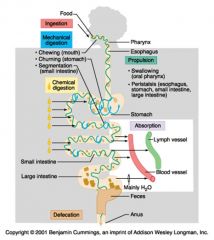
The mouth ingests food
|
|
|
What organ(s) are involved in mechanical digestion?
|

The mouth chews food.
The stomach churns food. The small intestine segments food. |
|
|
What organ(s) are involved in chemical digestion?
|
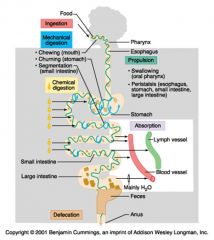
The mouth, stomach, and small intestine perform chemical digestion
|
|
|
What organ(s) are involved in propulsion?
|
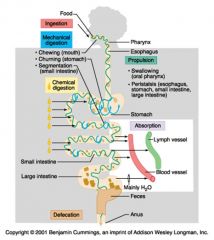
The oral pharynx performs swallowing.
The esophagus, stomach, small intestine, and large intestine all perform peristalsis. |
|
|
What organ(s) are involved in absorption?
|
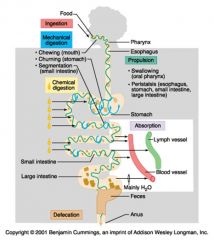
The small intestine and large intestine absorb nutrients.
|
|
|
Describe the process of swallowing.
|
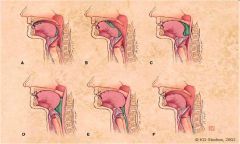
Swallowing. The process of swallowing consists of voluntary (buccal) and involuntary (pharyngeal-esophageal) phases. (a) During the buccal phase, the tongue pushes the food bolus posteriorly and against the soft palate. The soft palate rises to close off the nasal passages as the bolus enters the pharynx where the involuntary phase of swallowing begins. (b) The larynx rises so that the epiglottis covers its opening, preventing food from entering the lower respiratory passages. Relaxation of the upper esophageal sphincter allows food to enter the esophagus. (c) Peristalsis of the pharyngeal constrictor muscles forces the food through the esophagus to the stomach. The upper esophageal sphincter contracts again as the larynx and epiglottis return to their former positions.
|
|
|
What are peristalsis and segmentation?
|

Peristalsis moves food along the tract.
Segmentation is mixing and part of the mechanical digestion process. |
|
|
How does the body digest carbohydrates? What enzymes are involved? Where does it happen?
|

Starches are broken down into sugars by salivary amylase and pancreatic amylase in the mouth and small intestine. Those sugars are then broken down by brush border enzymes in the small intestine.
|
|
|
How does the body digest protein? What enzymes are involved? Where does it happen?
|
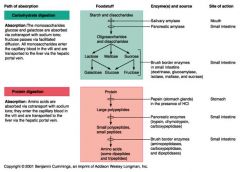
Proteins are broken down to large polypeptides by pepsin in the stomach (in the presence of HCl)
Those large polypeptides are broken down to small polypeptides and peptides by pancreatic enzymes (trypsin, chymotrypsin, and carboxypeptidase) in the small intestine. Finally, those small polypeptides and peptides are broken down to amino acids by brush border enzymes (aminopeptidases, carboxypeptidase, and dipeptidases) in the small intestine |
|
|
How does the body digest fats? What enzymes are involved? Where does it happen?
|
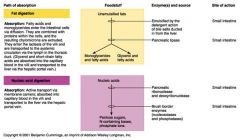
Fats are emulsified by bile salts (from the liver) in the small intestine, then broken down via pancreatic lipase into fatty acids, also in the small intestine.
(Lingual lipase, which also breaks down fat in the mouth, is not mentioned in this lesson) Proteins are broken down to large polypeptides by pepsin in the stomach (in the presence of HCl) Those large polypeptides are broken down to small polypeptides and peptides by pancreatic enzymes (trypsin, chymotrypsin, and carboxypeptidase) in the small intestine. Finally, those small polypeptides and peptides are broken down to amino acids by brush border enzymes (aminopeptidases, carboxypeptidase, and dipeptidases) in the small intestine |
|
|
How does the body digest nucleic acids? What enzymes are involved? Where does it happen?
|
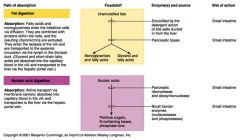
Pancreatic ribonuclease and deoxyribonuclease break them down into component sugars, bases, and ions, as well as some brush border enzymes, within the small intestine.
Fats are emulsified by bile salts (from the liver) in the small intestine, then broken down via pancreatic lipase into fatty acids, also in the small intestine. (Lingual lipase, which also breaks down fat in the mouth, is not mentioned in this lesson) Proteins are broken down to large polypeptides by pepsin in the stomach (in the presence of HCl) Those large polypeptides are broken down to small polypeptides and peptides by pancreatic enzymes (trypsin, chymotrypsin, and carboxypeptidase) in the small intestine. Finally, those small polypeptides and peptides are broken down to amino acids by brush border enzymes (aminopeptidases, carboxypeptidase, and dipeptidases) in the small intestine |
|
|
How are nutrients absorbed by the body?
|
Nearly all absorption occurs in the small intestine.
80% of the electrolytes and virtually all food Most nutrients are absorbed by active transport. Glucose, amino acids, & nucleic acids are absorbed by secondary active transport with sodium. Iron and calcium require transport proteins (ferritin) or cofactors (vitamin D). Anions follow Na+. Vitamins - Fat soluble (A, D, E & K) vitamins are carried with micelles. Much of the K is absorbed in the colon. Water soluble vitamins diffuse, with the exception of B12, which requires intrinsic factor. |
|
|
What substance serves to emulsify fats?
|
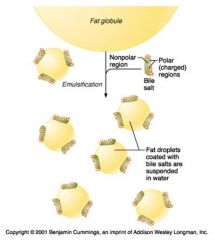
Bile salts emulsify fats. (Produced by the liver and stored in the gallbladder)
|
|
|
How are lipids absorbed?
|

Dietary fats are absorbed into the “lacteals” of the lymphatic system before being transferred to the circulatory system.
|
|
|
What is this a picture of?
|
Lacteals
|
|
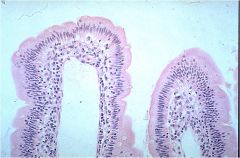
What is this a picture of?
|

Lacteals
|

